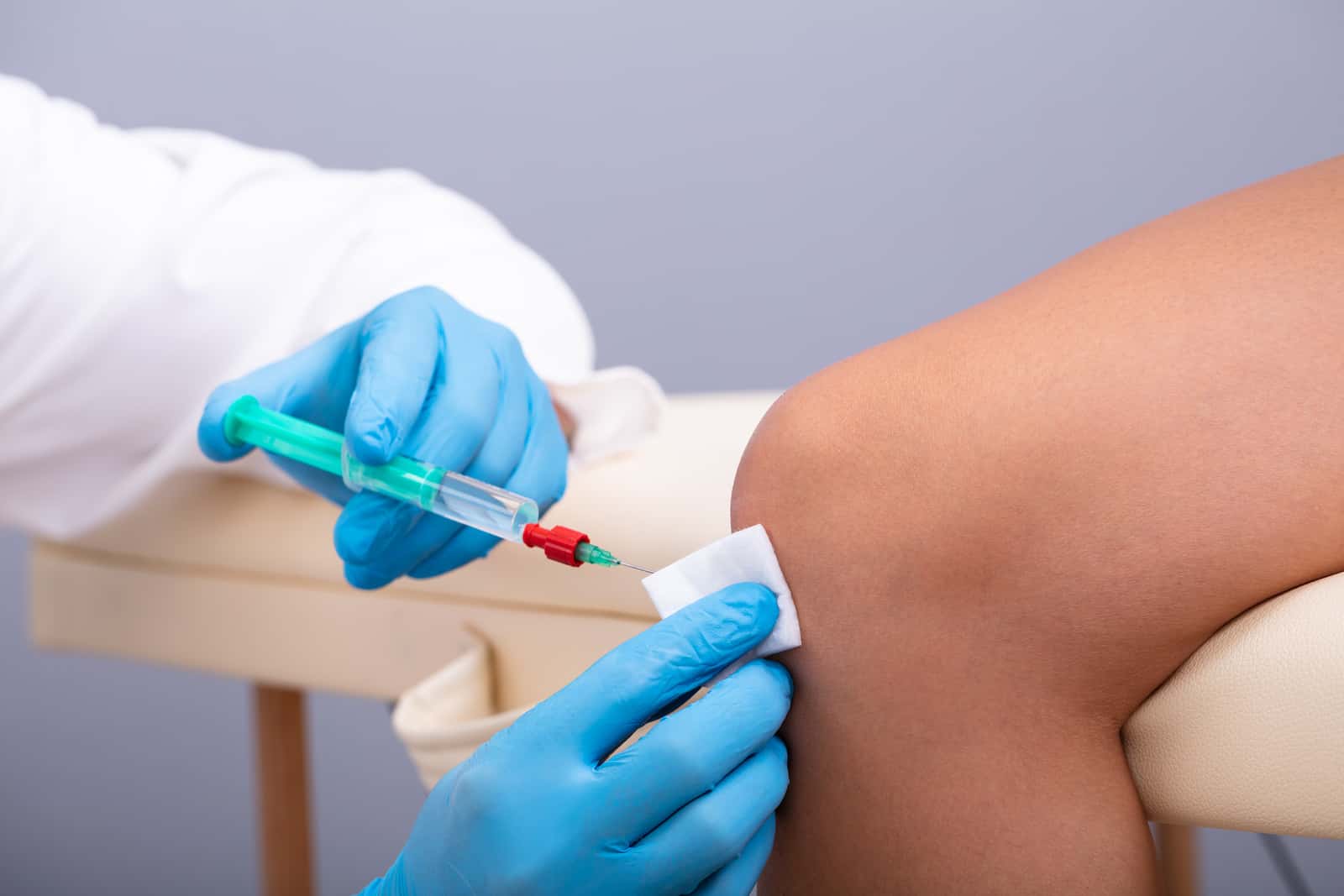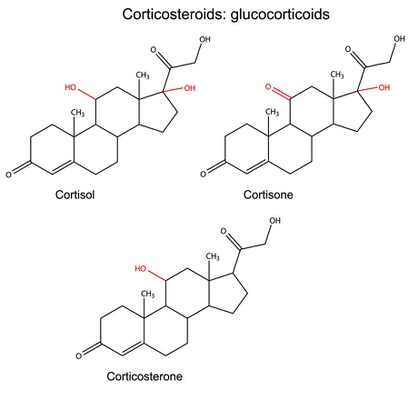
You have no doubt heard about “steroids.” By the way, this is a terrible term! It causes nothing but confusion. We promise not to overwhelm you with chemistry. The core structure of steroids can be found in hormones like estrogen, progesterone and testosterone as well as in corticosteroids like cortisone and prednisone. The steroid injections we are referring have nothing to do with body building. This is all about cortisone shots for joint pain and inflammation. A new study reveals that corticosteroid injections into the hip can lead to rapidly destructive hip disease or RDHD (Journal of Bone & Joint Surgery, Sept. 22, 2021).

Structural chemical formulas of corticosteroids (glucocorticoids): cortisol, cortisone, corticosterone
A Quick Overview of Cortisone:
A patient with rheumatoid arthritis first received cortisone just over 70 years ago. The results were impressive enough that doctors quickly embraced cortisone as a treatment for this crippling disease. By the early 1950s, patients were taking cortisone orally and receiving cortisone shots in their joints (Clinical and Experimental Rheumatology, Sept-Oct. 2011).
Cortisone was hailed as a miracle cure for rheumatoid arthritis. It reduced the pain and inflammation that crippled many patients.
People who relied upon crutches or wheelchairs to move could suddenly get around on their own. Doctors who prescribed oral cortisone or administered cortisone shots were seen as heroes by patients in severe pain.
The Darker Side of Corticosteroids Emerges:
Before long, however, the dark side of corticosteroids began to appear. Patients taking high doses for long periods of time experienced side effects such as hypertension, heart failure, diabetes, loss of potassium, blood clots, weight gain, cataracts, glaucoma, muscle weakness, bone loss and fractures.
A close family friend ended up with severe osteoporosis and horrible fractures after taking high-dose cortisone for many years.
Once doctors realized that there were serious tradeoffs to long-term, high-dose treatment with corticosteroids, they became more discriminating. Nowadays, drugs like prednisone are mostly reserved for serious conditions such as Addison’s disease, Crohn’s disease, lupus and cancers such as leukemia and multiple myeloma.
When people experience severe asthma attacks or life-threatening allergic reactions, they may get cortisone shots in an emergency department. We have no quarrel with such treatments.
You can read about my personal story with prednisone. This corticosteroid reversed my sudden deafness (idiopathic sudden sensorineural hearing loss). Here is a link:
Prednisone Side Effects: Deal With The Devil?
Cortisone Shots: A Risky Tradeoff?
Doctors often offer athletes and older patients with arthritis steroid injections into sore joints. There is a widespread belief that such cortisone shots can provide “localized” treatment.
Many people, including some health professionals, believe that the injection of a corticosteroid such as methylprednisolone, betamethasone or triamcinolone into a joint can ease symptoms without systemic (whole body) side effects. There is growing awareness that conception may be way too optimistic.
A Systemic Side Effect: Weight Gain?
A reader of our syndicated newspaper column asks this question:
Q. You have written about the pros and cons of cortisone injections. Have the effects on weight been studied?
I had steroid shots in my knees every three months for two years. I recently compared notes with a friend who has a similar history. Both of us gained weight — 35 pounds for me and 40 pounds for her. My blood sugar rose and, sadly, my arthritis got worse.
A. Many people are under the mistaken impression that a corticosteroid injection into a joint has only local effects. In reality, such shots can affect the entire body.
Some people report insomnia and anxiety after an injection. Others have trouble controlling their blood sugar. Prolonged corticosteroid treatment is also linked to weight gain (Allergy, Asthma & Clinical Immunology, Aug. 15, 2013).
Cortisone Shots and Joint Deterioration:
A review in the journal Radiology (Oct. 15, 2019) highlights some unpleasant reactions to such injections. Among the most worrisome is that corticosteroids can accelerate the progression of osteoarthritis in that joint.
In addition, if the bone tissue has begun to die (osteonecrosis), the steroid injection can make that worse. Certain types of stress fractures also become more likely, along with bone loss and rapid joint destruction.
Cortisone Shots and Rapidly Destructive Hip Disease (RDHD):
When people complain of hip pain due to osteoarthritis, doctors frequently offer a corticosteroid injection. There is growing concern, however, that such treatment may lead to rapidly destructive hip disease or RDHD.
Researchers at a hospital in Honolulu (Kaiser Permanente Hawaii) tracked patients who had treatment for RDHD between 2013 and 2016. Those who had received steroid injections into their hip joints were over eight times more likely to experience rapid degeneration of the joint. The higher the dose and the more injections, the worse the outcome.
Why Do Corticosteroid Injections Damage Joint?
The authors of the study published in the Journal of Bone & Joint Surgery (Sept. 22, 2021) point out:
“With regard to biologic plausibility, the potential for corticosteroids to injure articular cartilage is well established. In a systematic review, Wernecke et al. concluded that intra- articular corticosteroid had a dose-dependent injurious effect on cartilage in vitro as well as in vivo. In the clinical setting, corticosteroid injections have been linked to an increased risk of osteoarthritic progression in the hip and knee.”
A reader of our syndicated newspaper column told us that an orthopedic surgeon said:
“rheumatologists are good for their business”
Why are rheumatologists good for orthopedic surgeons? Because corticosteroid injections into knees and hips may be accelerating osteoarthritis of the joints. As the tissue deteriorates, the need for joint replacement surgery increases. You can read more about this complication at this link.
Benefitting from Cortisone Shots:
Some people who have had such injections have been very pleased with the results.
One reader remarked:
“At around 60 years old, I’d have been unable to continue my daily 25-minute walk had I not had a knee injection. It did not hurt much. A few years later, I repeated it.
“Since then (I’m 71 now), I’ve not had any significant problems and have walked every day. I strengthen my knees at home with easy exercise and eat a very nutritious diet that keeps me thin.”
Lizzie reports benefit from cortisone shots:
“I had three instances of corticosteroid injection in a hip joint for severe bursitis. It didn’t hurt. It helped. Bursitis cleared up with no relapse in the past thirty years. No arthritis or joint problems in hips again. So far!”
A Darker Side of Cortisone Shots:
Others have not had such good results.
According to another reader:
“I recently had two cortisone injections at one time, hip and sacroiliac joint. I was immediately so anxious I was in agony. I am still having trouble sleeping after three weeks. My blood pressure shot up to 170 over 85 for a few days. My blood sugar levels were also unusually high.
“I lost 4 pounds in a week, although I was eating as usual. All in all, it was a horrible experience. And only one of the two injections relieved my pain. I will never have another cortisone shot.”
This reader’s experience demonstrates that even local treatments can have effects throughout the body. Insomnia, anxiety, hypertension and elevated blood sugar are well recognized systemic reactions to corticosteroids.
Taylor has seemingly experienced rapid knee deterioration from steroid injections:
“I am only 30 but I have already had eight knee surgeries. I used to get cortisone shots to get through a season. They worked great. I didn’t think there were any problems getting the injections every year. My doctors administered them willingly.
“I now have extremely bad arthritis. I am waiting to get a total knee replacement. The trick is finding a doctor who will perform this surgery on someone my age. It is interesting to think that those many years of cortisone shots might have actually made my knee problems get worse faster.”
Rose has a somewhat similar story:
“I have had a cortisone injection in both my knees every 3-4 months for the past four years. Now I have bone on bone osteoarthritis in both knees.
“When I would ask my doctor if there was any danger from the cortisone shots he would always say no. He said that I could continue to get them every three months. My last shot in my left knee was three weeks ago. I got no relief at all.
“I am finally going to bite the bullet and have a total knee replacement. I fear that when they cut me open my joints and leg bones may not be strong enough to hold the replacement.”
Balancing Benefits and Risks of Cortisone Shots:
As you can tell, some people benefit from corticosteroid injections. This seems to be especially true if there is localized inflammation such as bursitis. If the cortisone shots are not administered too often, it is conceivable that lasting damage can be prevented.
On the other hand, the evidence is mounting that frequent injections can lead to joint damage. You can read much more about the actual mechanism whereby this happens at this link:
Corticosteroid Injections in Joints Accelerate Arthritis
Learn More:
Learn a lot more about other ways to deal with arthritis in our eGuide to Alternatives for Arthritis. This online resource is available at this link.
Share your own experience with cortisone shots in the comment section below. We would love to hear both sides of this controversial subject.
Do you appreciate The People’s Pharmacy? We try to be your Drug Watchdog, keeping an eye on Big Pharma, the generic drug industry and the FDA. You can share this article by scrolling to the top of the page and clicking on icons for email, Facebook or Twitter. Please share with a friend or family member.
If our independent voice is important to you, please consider supporting our work by signing up for our ad-free option at this link. You can also make a one-time donation at this link. Many thanks!
Citations
- Benedek, T. G. “History of the Development of Corticosteroid Therapy,” Clinical and Experimental Rheumatology, Sept-Oct. 2011, PMID: 22018177
- Kompel AJ et al, "Intra-articular corticosteroid injections in the hip and knee: Perhaps not as safe as we thought?" Radiology, Oct. 15, 2019. https://doi.org/10.1148/radiol.2019190341

